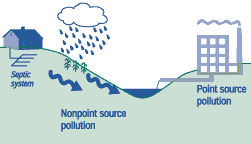|
Potential Sources of Water Pollution
in LaPorte County
Pollutants can be separated into two categories, point source and
nonpoint source, depending on how they get into the water. Point
source pollution refers to contaminants that enter the water directly,
usually through a pipe. Examples are sewage treatment plants and
industrial facilities, which have permits to discharge prescribed
quantities of potential contaminants into a specific stream. Nonpoint
source pollution, by contrast, originates across the watershed and
enters the water at locations that cannot be easily identified.
Examples of nonpoint source pollution include sediments, nutrients,
pesticides, oil, and other chemicals. Point and nonpoint source
pollution are illustrated in Figure 10. Nonpoint source pollution,
which is not regulated, is currently the primary cause of water
quality degradation in the U.S.
 |
| Figure 10. Point source and
nonpoint source pollution. |
Potential Point Source Pollution Because point source discharges
require permits, excellent information is available about potential
point sources discharging in LaPorte County. Twenty-three facilities
(municipal sewage treatment plants, factories, schools, packing
plants, etc.) were permitted to discharge wastes in LaPorte County’s
water in 1996. The largest dischargers in LaPorte County are NIPSCO
in Michigan City, the Michigan City Sanitary District, LaPorte
Municipal Sewage Treatment Plant, and Roll Coater in Kingsbury.
They have permits to discharge substances like suspended solids,
ammonia, cadmium, copper, lead, and chlorine. A limited amount
of flow is allowed to by-pass the sewage treatment plants during
storms.
The three Superfund sites in LaPorte County can be considered
point sources of ground water contamination.
The 250-acre Fisher-Calo site near Kingsbury previously housed
a U.S. military installation used to manufacture weapons. This
was followed by an industrial park. Ground water was contaminated
by volatile organic compounds (VOCs), and the soil contains PCBs
and semi-volatiles. Extensive cleanup is taking place at the site,
including the removal of about 3,500 buried drums and 4,000 surface
barrels. Contaminated soil is being treated, and ground water
is being pumped and treated with air stripping. The 32-acre Waste,
Inc. landfill east of Michigan City accepted approximately 128,000
tons of industrial wastes from 1966-1982. The landfill was unlined,
and there were no dikes to control runoff. Groundwater and soils
at the site, as well as sediments in Trail Creek were contaminated.
The landfill has now been closed and capped. The third Superfund
site is Cam-Or in Westville where contaminated soil and groundwater
are being treated. For more information contact the LaPorte County
office of Emergency Planning and Hazardous Material at 326-7700
x265 or the Laporte County Health Department.
Potential Nonpoint
Source
Pollution Potential nonpoint source pollution exists everywhere
in the watershed. Sediment is the largest pollutant by volume
in most Indiana streams. Sources of sediment include farm fields,
construction sites, and streambank erosion. Although some erosion
is natural, flow changes due to development (increased impervious
area) may increase streambank erosion. Nutrients, such as phosphorus
or nitrogen, are potential pollutants in either ground or surface
water. Nutrients can come from urban or rural areas, and result
from normal home and farm operations as well as accidents or spills.
Major sources of nutrients include septic systems, fertilizers,
and livestock manure.
Urban and Residential
Nonpoint Sources
Septic systems have the potential of leaching nutrients into the
ground water and can contaminate the surface water if the system
is not functioning properly. According to the 1990 census, of
the 42,268 households in LaPorte County, 43% use a septic system
for waste disposal, while the other 57% of the housing units are
connected to the public sewer system (which treats the waste and
then discharges into a river or lake as a point source). No information
is available on how well the 18,000 septic systems in the county
are performing. Salt, oil, fertilizers for lawns, and antifreeze
are other examples of urban pollutants that can be washed off
from rain and enter the water system as pollutants. No figures
are available on urban lawn chemicals and runoff, which may be
significant sources of pollution from residential areas. Household
hazardous wastes can also contaminate water if not disposed of
properly.
Agricultural
Nonpoint Sources
Agriculture can also contribute to nonpoint source pollution.
Sediment, nutrients and pesticides can be transported by water
from cropped fields and land where manure is applied. Roughly
215,000 acres or 55% of LaPorte County is used for planting crops.
About 56% of cropped fields were in corn in 1994, with the remainder
mainly in soybeans and small grains.
Information on fertilizer sales from the Office of the Indiana
State Chemist shows that 18,974 tons of fertilizer were sold in
LaPorte County in 1996. Manure from livestock may also contribute
nutrients to ground and surface water. Livestock in 1994 included
more than 21,000 cattle and 31,000 hogs. Large livestock facilities
must be permitted by the Indiana Department of Environmental Management.
No statistics are available for pesticide use or runoff in LaPorte
County. Indiana Agricultural Statistics tracks pesticide use statewide
and this information could be assumed to represent LaPorte County.
In Indiana in 1995, the most widely used pesticides were the herbicides
atrazine, alachlor, and metolachlor. Large-scale studies carried
out in Indiana and elsewhere have shown that typically about 1%
of applied pesticides end up in lakes or rivers.
Many farmers are changing their practices to protect water resources.
Erosion and chemical runoff from fields can often be reduced by
using conservation tillage, defined as any tillage system that
leaves 30 percent or more of the soil surface covered with crop
residue. Conservation tillage was used on 25% of the cropland
of LaPorte County in 1995. Some farmers are scouting their fields
so that only necessary pesticides are applied. Many farmers test
their soils to ensure that crops only receive the amount of fertilizer
that is needed, and some have installed grass waterways and buffer
strips to protect water quality and provide habitat for wildlife.
|

